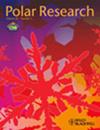冻土带和森林中的有机碳和微生物组——俄罗斯亚马尔南部冻土带永久冻土
IF 1.3
4区 地球科学
Q3 ECOLOGY
引用次数: 5
摘要
永久冻土与其他土壤有很大不同,因为它们是第四纪期间积累的有机碳的巨大储存库,随着北极变暖,这些有机碳有被释放的危险。本研究旨在描述俄罗斯南部亚马尔地区冻土带和森林冻土带永久冻土土壤中现有碳库的特征,描绘土壤有机质可能的矿化风险,并评估微生物群落。由于土壤剖面中低温发生的表现,碳、氮和C:N的剖面分布随深度呈非渐进式变化,导致低温传质。研究区平均碳储量分别为7.85±2.24 kg m−2 (0 ~ 10 cm)、14.97±5.53 kg m−2 (0 ~ 30 cm)和23.99±8.00 kg m−2 (0 ~ 100 cm)。腐殖质类型分析显示,腐殖质组分以黄腐酸型和低分子量片段为主,表明北极变暖条件下腐殖质具有较高的矿化风险。土壤微生物组的分类分析显示48个细菌和古细菌门,其中以变形菌门(27%)和放线菌门(20%)为主。pH范围和氮积累是影响土壤微生物群落多样性和组成的主要环境因素。本文章由计算机程序翻译,如有差异,请以英文原文为准。
Organic carbon and microbiome in tundra and forest–tundra permafrost soils, southern Yamal, Russia
Permafrost soils differ significantly from other soils because they serve as a huge reservoir for organic carbon accumulated during the Quaternary Period, which is at risk of being released as the Arctic warms. This study aimed to characterize existing carbon pools, delineate possible mineralization risks of soil organic matter and assess microbial communities in the tundra and forest–tundra permafrost soils of the southern Yamal region of Russia. The profile distribution of carbon, nitrogen and the C:N ratio showed non-gradual changes with depth due to the manifestation of cryopedogenesis in soil profiles, which lead to cryogenic mass transfer. Mean carbon stocks for the study area were 7.85 ± 2.24 kg m−2 (0–10 cm layer), 14.97 ± 5.53 kg m−2 (0–30 cm) and 23.99 ± 8.00 kg m−2 (0–100 cm). The analysis of the humus type revealed a predominance of fulvic type and low-molecular-weight fragments in the fulvic acid fraction, which indicates high mineralization risk of humic substances under Arctic warming conditions. The taxonomic analysis of soil microbiomes revealed 48 bacterial and archaeal phyla, among which proteobacteria (27%) and actinobacteria (20%) were predominant. The pH range and nitrogen accumulation were the main environmental determinants of microbial community diversity and composition in the studied soils.
求助全文
通过发布文献求助,成功后即可免费获取论文全文。
去求助
来源期刊

Polar Research
地学-地球科学综合
CiteScore
3.20
自引率
5.30%
发文量
22
审稿时长
>12 weeks
期刊介绍:
Since 1982, Polar Research has been the international, peer-reviewed journal of the Norwegian Polar Institute, Norway''s central institution for research, environmental monitoring and mapping of the polar regions. Aiming to promote the exchange of scientific knowledge about the Arctic and Antarctic across disciplinary boundaries, Polar Research serves an international community of researchers and managers. As an open-access journal, Polar Research makes its contents freely available to the general public.
Original primary research papers comprise the mainstay of Polar Research. Review articles, brief research notes, letters to the editor and book reviews are also included. Special issues are published from time to time.
The scope of Polar Research encompasses research in all scientific disciplines relevant to the polar regions. These include, but are not limited to, the subfields of biology, ecology, geology, oceanography, glaciology and atmospheric science. Submissions from the social sciences and those focusing on polar management and policy issues are welcome. Contributions about Antarctica are particularly encouraged.
 求助内容:
求助内容: 应助结果提醒方式:
应助结果提醒方式:


